Potrebujeme váš súhlas na využitie jednotlivých dát, aby sa vám okrem iného mohli ukazovať informácie týkajúce sa vašich záujmov. Súhlas udelíte kliknutím na tlačidlo „OK“.
ASTM D6956-11
Standard Guide for Demonstrating and Assessing Whether a Chemical Analytical Measurement System Provides Analytical Results Consistent with Their Intended Use
Automaticky preložený názov:
Štandardné Guide pre preukázanie a posúdenie, či Chemical Analytická meraní systém poskytuje analytické výsledky v súlade s ich plánovaným použitím
NORMA vydaná dňa 1.7.2011
Informácie o norme:
Označenie normy: ASTM D6956-11
Poznámka: NEPLATNÁ
Dátum vydania normy: 1.7.2011
Kód tovaru: NS-37115
Počet strán: 12
Približná hmotnosť: 36 g (0.08 libier)
Krajina: Americká technická norma
Kategória: Technické normy ASTM
Kategórie - podobné normy:
Anotácia textu normy ASTM D6956-11 :
Keywords:
chemical, analytical, measurement system, analytical results, ICS Number Code 71.040.40 (Chemical analysis)
Doplňujúce informácie
| Significance and Use | ||||||||||||||||||||||||
|
This guide is intended for use by both generators and users of analytical results. It is intended to promote consistent demonstration and documentation of the quality of the measurement results and facilitate determination of the validity of measurements for their intended use. This guide specifies documentation that a laboratory should supply with the analytical results to establish that the resulting measurements: (1) meet measurement quality requirements; (2) are suitable for their intended use; and (3) are technically defensible. While the guide describes information that the measurement results provider needs to give the user/decision maker, in order for measurement providers to supply data users with appropriate data, information is needed from the data user. Examples of information that the user should provide to the laboratory, in addition to the analytes of concern (including the form of the analyte that is to be determined, for example, total lead, dissolved lead, organic lead, inorganic lead), include but are not limited to: Type of material (that is, matrixfresh or salt water, coal fly ash, sandy loam soil, wastewater treatment sludge), Maximum sample holding time, Projected sampling date and delivery date to the laboratory, Method of chemical preservation (for example, not preserved, chemical used), Chain-of-custody requirements, if any, Analytical methods that must be used, if any, Measurement quality requirements expressed as DQOs or MQOs and action limits, Allowable interferences as described in 10.4, Documentation requirement, and Subcontracting restrictions/requirements. Users/decision makers should consult with the laboratory about these issues during the analytical design stage. This will allow the design of sample collection process and project schedule to accommodate the laboratory activities necessary to determine the desired level of measurement quality. The number of samples, budgets, and schedules should also be discussed. |
||||||||||||||||||||||||
| 1. Scope | ||||||||||||||||||||||||
|
1.1 This guide describes an approach for demonstrating the quality of analytical chemical measurement results from the application of a measurement system (that is, method or sequence of methods) to the analysis of environmental samples of soil, water, air, or waste. The purpose of such measurements can include demonstrating compliance with a regulatory limit, determining whether a site is contaminated above some specified level, or determining treatment process efficacy. 1.2 This guide describes a procedure that can be used to assess a measurement system used to generate analytical results for a specific purpose. Users and reviewers of the analytical results can determine, with a known level of confidence, if they meet the quality requirements and are suitable for the intended use. 1.3 This protocol does not address the general components of laboratory quality systems necessary to ensure the overall quality of laboratory operations. For such systems, the user is referred to International Standards Organization (ISO) Standard 17025 or the National Environmental Laboratory Accreditation Conference (NELAC) laboratory accreditation standards. 1.4 The values stated in SI units are to be regarded as standard. No other units of measurement are included in this standard. 1.5 This standard does not purport to address all of the safety concerns, if any, associated with its use. It is the responsibility of the user of this standard to establish appropriate safety and health practices and determine the applicability of regulatory requirements prior to use. |
||||||||||||||||||||||||
| 2. Referenced Documents | ||||||||||||||||||||||||
|
Podobné normy:
Historická
1.11.2011
Historická
1.8.2012
Historická
1.6.2013
Historická
1.4.2014
Historická
1.4.2009
Historická
27.1.2012


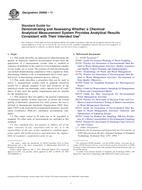
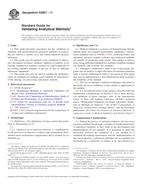 ASTM E2857-11
ASTM E2857-11 ASTM E2882-12
ASTM E2882-12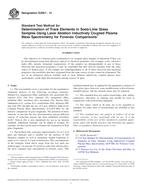 ASTM E2927-13
ASTM E2927-13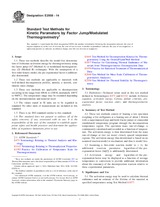 ASTM E2958-14
ASTM E2958-14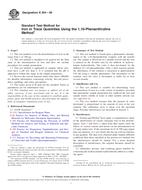 ASTM E394-09
ASTM E394-09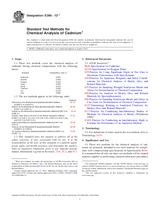 ASTM E396-12e1
ASTM E396-12e1
 Cookies
Cookies
